Washington, D.C. exudes a throbbing vitality that is unmatched in the United States, whether you are admiring its white marble monuments and memorials, learning about history in one of its free museums, or getting a sense of how residents live in one of its lively neighbourhoods. You may visit the District of Colombia dozens of times and each time be in for an entirely new experience. America’s capital, Washington, D.C., was asked to have Pierre-Charles L’Enfant design it. The city is located on the Potomac River between Maryland and Virginia. Situated on property set aside expressly to prevent the federal government from locating in a single state following the Revolutionary War.
With its broad avenues, inspirational marble buildings, public squares, and the National Mall—a spectacular “public walk”—L’Enfant designed Washington, D.C. to feel larger than life. The city is laid up as a grid of streets with avenues connecting each of the four quadrants: NW, NE, SW, and SE.
Its list of must-see sights, which includes the Capitol Building, the White House, and many museums, monuments, and memorials thoughtfully arranged along the park-like National Mall, draws hordes of first-time visitors. But there’s more Washington, DC, than just these well-known sights. U Street, Adams Morgan, Dupont Circle, Georgetown, and other unique neighbourhoods abound in this city of long-term foreign immigrants impacted by local governance.
In just a few miles, you can traverse the entirety of the global cuisine scene in one metropolis. In addition, the city offers top-notch outdoor activities including paddleboarding on the Potomac River and strolling or bicycling along the C&O Canal towpath.
Plan your trip to the nation’s capital with our list of the top attractions in Washington, D.C.
1. United States Capitol and Capitol Hill
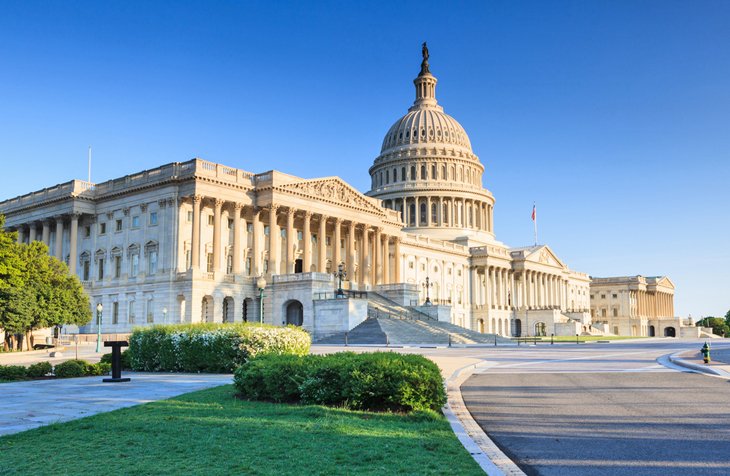
The Capitol, which houses the Senate and the House of Representatives, is widely acknowledged as a symbol of the United States. Above all other Washington buildings, the enormous dome—which was modelled after the dome of St. Peter’s in Rome—stands out. The centre portion of the building was constructed between 1793 and 1812, and like Washington itself, it has expanded over time. In 1958–1962, the main façade—where presidents take the oath—was extended. A marble patio on the opposite side provides stunning views of the city and the shopping centre.
The inside is awash in murals, reliefs, and paintings, particularly in the rotunda beneath the massive cast-iron dome, which features a painting by Constantino Brumidi on the ceiling and enormous murals depicting historical events in American history on the walls. Next to it stands the former House of Representatives chamber, which is decorated with statues of notable historical personalities. The exquisitely renovated Old Senate Chamber, where the Senate convened until 1859 and the Supreme Court until 1935, can be accessed through the modest Senate Rotunda.
2. The Lincoln Memorial
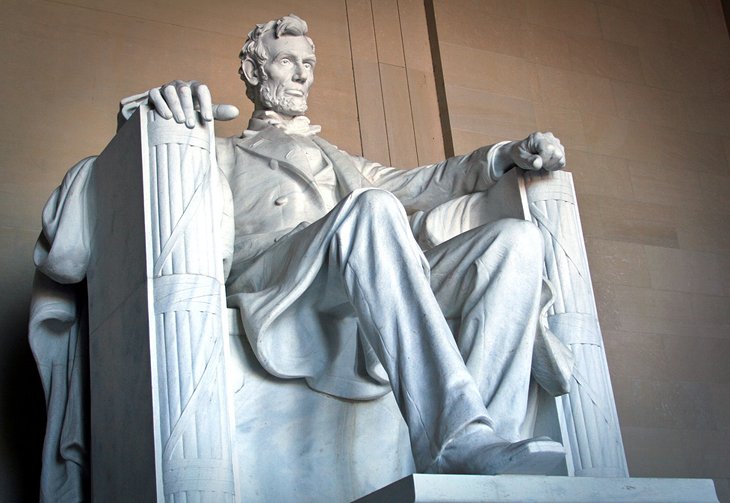
The Lincoln Memorial, the most beloved of all the Washington monuments, is located at the far end of the mall, across the Reflecting Pool from the Washington Monument. 36 columns, one for each of the states that existed at the time of Lincoln’s death, surround the 19-foot marble statue of the sitting, thoughtful President Abraham Lincoln. The most well-known piece created by renowned sculptor Daniel Chester French is this one. The interior walls have murals by Jules Guerin that depict significant moments in Abraham Lincoln’s life.
Many significant historical events have taken place at the Lincoln Memorial since it was completed in 1922. President Franklin D. Roosevelt and First Lady Eleanor Roosevelt arranged for renowned African American singer Marian Anderson to give an outdoor concert on the steps of the Lincoln Memorial in 1939 after the all-white Daughters of the American Revolution (DAR) forbade her from performing at a concert in nearby Constitution Hall. The event drew 75,000 attendees and was broadcast to millions of radio listeners.
3. National Mall and Veterans Memorials
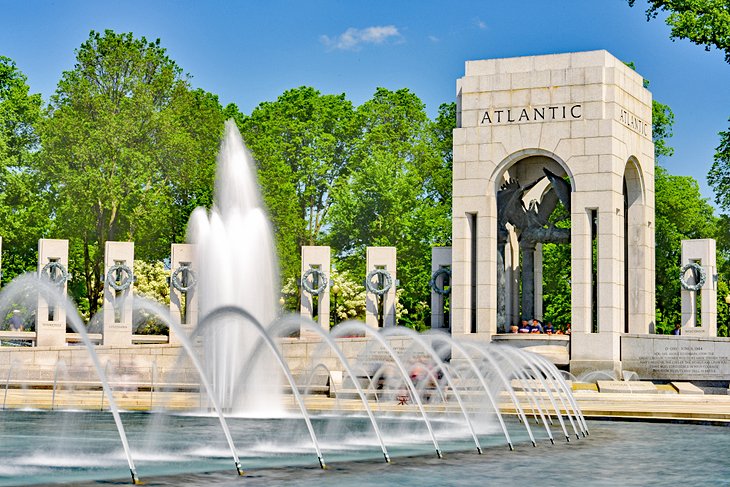
Many of Washington’s famous structures and monuments are located within the expansive greenbelt that stretches from the Capitol Building to the Lincoln Memorial. The greenbelt is made up of lawns and pools. The Washington Monument, which stands most prominently in the middle, is flanked by war memorials honouring veterans of the Vietnam, Korea, and World Wars II.
One of Washington’s most popular memorials is the Vietnam Veterans Memorial, a moving wall bearing the names of every American military member who died or went missing in action. There’s a bronze sculpture of three servicewomen tending to a wounded soldier at the neighbouring Vietnam Women’s Memorial. There are nineteen soldier-themed steel sculptures at the Korean War Veterans Memorial. 2014 saw the dedication of the newest memorial, the American Veterans Disabled for Life Memorial.
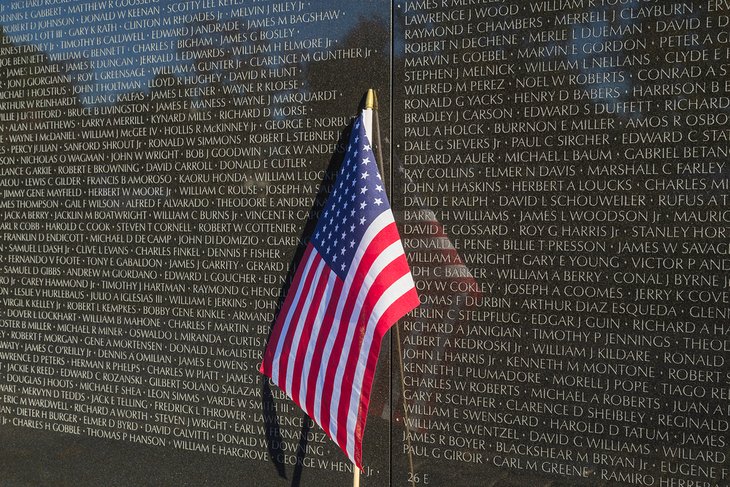
You’re probably going to spend a lot of time here because, as you can see from a map of Washington, D.C. attractions, many of them are located along the National Mall. The Mall hosts festivals and celebrations in addition to having a park for jogging, walking, and picnicking. The most well-known of these is the yearly fireworks extravaganza around the Washington Monument on Independence Day.
The Smithsonian American Folk Life Festival takes place in July and packs the Mall with cuisine, music, storytelling, crafts, performances, and cultural events from across the nation. This location hosts the Smithsonian Kite Festival in late March or early April.
There are frequently military bands playing at locations along the Mall during summer evenings. Tuesdays at Navy Memorial and Mondays at the Capitol steps with a view of the Mall are concerts by the US Navy Band. Tuesdays and Fridays, the US Air Force Band plays at the Air Force Memorial and on the steps of the capitol.
4. The White House

The President of the United States resides in the White House for official business. With the exception of George Washington, every president has lived there. James Hoban first constructed it in 1792, and it was reconstructed in 1818 after British forces set it on fire in 1814. Every visitor to Washington will want to see this magnificent edifice, if only from the outside. Interior tours, which take in the East, Blue, Green and Red Rooms; the Ballroom; and the State Dining Room, must be scheduled well in advance through your Congressional office or consulate.
Excellent interactive exhibits that display information on the White House and the presidential families may be found at the nearby White House Visitor Centre, which is free to access. Past presidents’ furnishings, a model of the home, historical details, and films featuring the presidents’ perspectives on their stays are all included.
The US Army Band performs summer concerts in The Ellipse, a 54-acre lawn that stretches to Constitution Avenue. The ornate 1833 Greek Revival Treasury Building and the 1871 Executive Office Building, one of Washington’s most outstanding historic government structures, are located very next to the White House. Statues of Lafayette and other figures overlook the White House from Lafayette Square, one of the most famous in the city.
5. The Washington Monument
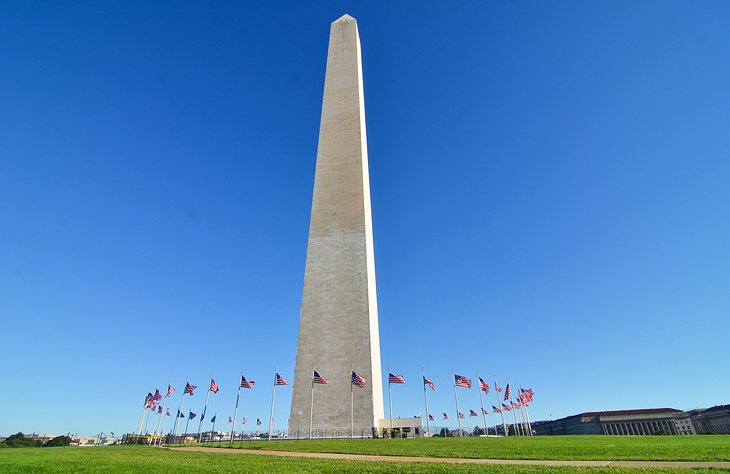
A well-known symbol of the National Mall, the 555-foot white shaft of the Washington Monument is a stunning sight, especially when reflected in the lengthy Reflecting Pool at its base. Not everything went according to plan when building the obelisk to honour the country’s first president. Congress gave its approval to the proposal in 1783, but construction didn’t begin until 1848. After the tower’s height reached 156 feet in 1854, political squabbles and financial difficulties halted construction for a number of years. The Civil War also caused more delays, resulting in the tower’s completion by the Army Corps of Engineers not occurring until 1885.
Inside are engraved stones from states, cities, foreign nations, individuals, and civic groups, many of whom were benefactors who assisted in its private fundraising stages. You can still distinguish the distinct stages of its construction by the three colour changes in its facing stones. For panoramic views over the mall and most of Washington, ride the lift to the very top. A circle of fifty American flags encircles the monument’s foundation.
6. National Air and Space Museum

One of the most visited museums in the world, the National Air and Space Museum houses a collection of historic aircraft and spacecraft, such as the first Wright Brothers Flyer, built in 1903, and Charles Lindbergh’s Spirit of St. Louis, the first aircraft to fly across the Atlantic Ocean alone.
Here, the Apollo 11 command module—a component of the first manned lunar landing mission—represents more recent flight history. A range of topics, including the use of air power in both world wars, the space race, flying pioneers, and current advancements in space and aviation technology, are covered in both permanent and temporary displays that showcase the science, history, and technology of aviation and space travel.
You can engage with several of the exhibits, which all feature real historical artefacts like a touchable moon rock. In addition to illuminating history, permanent exhibits also demonstrate the how and why of space science and flight, elucidating the workings of jet engines, how objects fly, and what maintains the International Space Station in orbit.
Apart from the displays, there’s the IMAX theatre, the Albert Einstein Planetarium, and the Public Observatory located on the east terrace. Here, you may study lunar craters and use telescopes to see planets and other celestial objects. Children and adults can experience naval aviation in an F-18 Super Hornet or fly combat missions with aerial manoeuvres including 360-degree barrel spins using flight simulators (price charged).
7. National Gallery of Art

Housed in two separate buildings connected by a tunnel, the National Gallery of Art is one of the world’s premier art museums and one of the most popular in the U.S. Based on the sizable collection of financier and later Treasury Secretary Andrew Mellon, its large and diverse collection includes masterpieces of European and American paintings, sculpture, and decorative arts. Frequent temporary exhibitions add to this outstanding permanent collection to highlight arts from cultures around the world. Among the highlights is Ginevra de Benci, the only Da Vinci painting in any American museum. Others include works by major French Impressionists – Monet, Degas, and Renoir — and other masterpieces by Rembrandt, El Greco, and Vermeer.
The newer East Wing features sculptures by Henry Moore, a mobile by Alexander Calder, and other modern works. Free concerts are held at the National Gallery on Sunday evenings from fall through spring.
FAQ’S:
Q1: What are the must-visit monuments in Washington, D.C.?
The top monuments include the iconic Washington Monument, the Lincoln Memorial, the Jefferson Memorial, and the Vietnam Veterans Memorial. These landmarks showcase the rich history and significance of the nation's capital.
Q2: Which museums are highly recommended for visitors in Washington, D.C.?
The Smithsonian museums are a must-visit, especially the National Air and Space Museum, the National Museum of American History, and the National Gallery of Art. These institutions offer a diverse range of exhibits and collections.
Read More: Alaska’s Top 10 Best Bakeries